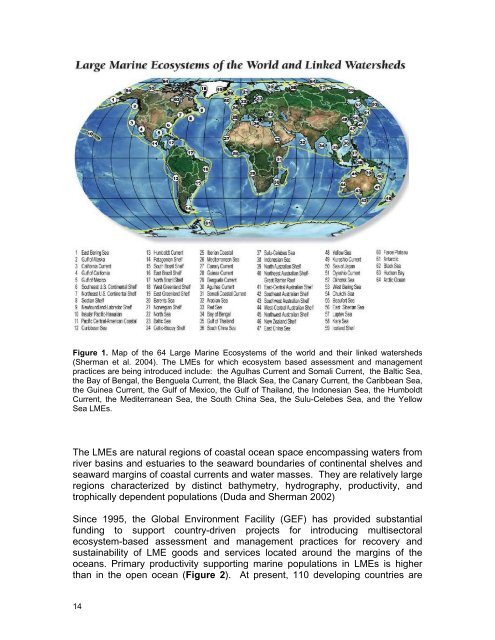Sustaining the World's Large Marine Ecosystems
Sustaining the World's Large Marine Ecosystems
Sustaining the World's Large Marine Ecosystems
Create successful ePaper yourself
Turn your PDF publications into a flip-book with our unique Google optimized e-Paper software.
Figure 1. Map of <strong>the</strong> 64 <strong>Large</strong> <strong>Marine</strong> <strong>Ecosystems</strong> of <strong>the</strong> world and <strong>the</strong>ir linked watersheds<br />
(Sherman et al. 2004). The LMEs for which ecosystem based assessment and management<br />
practices are being introduced include: <strong>the</strong> Agulhas Current and Somali Current, <strong>the</strong> Baltic Sea,<br />
<strong>the</strong> Bay of Bengal, <strong>the</strong> Benguela Current, <strong>the</strong> Black Sea, <strong>the</strong> Canary Current, <strong>the</strong> Caribbean Sea,<br />
<strong>the</strong> Guinea Current, <strong>the</strong> Gulf of Mexico, <strong>the</strong> Gulf of Thailand, <strong>the</strong> Indonesian Sea, <strong>the</strong> Humboldt<br />
Current, <strong>the</strong> Mediterranean Sea, <strong>the</strong> South China Sea, <strong>the</strong> Sulu-Celebes Sea, and <strong>the</strong> Yellow<br />
Sea LMEs.<br />
The LMEs are natural regions of coastal ocean space encompassing waters from<br />
river basins and estuaries to <strong>the</strong> seaward boundaries of continental shelves and<br />
seaward margins of coastal currents and water masses. They are relatively large<br />
regions characterized by distinct bathymetry, hydrography, productivity, and<br />
trophically dependent populations (Duda and Sherman 2002)<br />
Since 1995, <strong>the</strong> Global Environment Facility (GEF) has provided substantial<br />
funding to support country-driven projects for introducing multisectoral<br />
ecosystem-based assessment and management practices for recovery and<br />
sustainability of LME goods and services located around <strong>the</strong> margins of <strong>the</strong><br />
oceans. Primary productivity supporting marine populations in LMEs is higher<br />
than in <strong>the</strong> open ocean (Figure 2). At present, 110 developing countries are<br />
14









